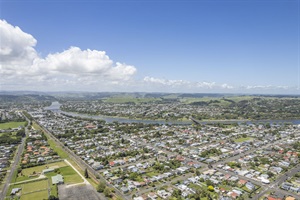Council working on new approach to housing shortage
Published on 10 April 2024

Whanganui District Council is working on a new approach to address the district’s housing woes – and the first step will be a business case for a standalone social housing entity to drive growth in Whanganui’s housing stock.
Councillor Kate Joblin says Whanganui has a high number of people on a waitlist for social housing. “There were at least 318 individuals on the MSD housing register in September 2023. This is an increase of 231 percent from September 2019.”
She says rental affordability is worsening in Whanganui, with an average weekly rent price of $433. “This is growing faster than the rest of the country. In terms of affordability (the amount of household income spent on rent) Whanganui ranks 45th out of 66 Territorial Authorities.
“Our current housing rental stock is also failing to meet warm dry home standards and this is directly impacting our community’s health and well-being.”
Mayor Andrew Tripe says Whanganui’s population is projected to increase from 48,700 in 2022 to 52,981 by 2034 and nationally the older population is expected to increase from 21.5% to 30% by 2048.
“Based on current data, we’re going to need at least 1,000 new dwellings over the next 10 years to close the gaps.”
He says Whanganui District Council wants to grow the existing housing stock and take a more active role in ensuring the community has access to a range of housing choices.
Kate Joblin says, “We’re considering the benefits of establishing a separate social housing entity as a Special Purpose Vehicle to deliver social housing for Whanganui.
“A standalone entity would have a dedicated board with the right capability and would be able to register and become a Community Housing Provider (CHP). That would enable it to access income-related rent subsidies and operational funding from the Ministry of Housing and Urban Development, as well as private equity funding or partnership opportunities.
“We’ve been looking with interest at a number of different housing models operating successfully across New Zealand,” she says, “And reviewing these alongside the Turley’s report on housing in Whanganui which was commissioned and received 18 months ago.
“In general, the different models all encompass key elements that create sustainable, inclusive and supportive living environments. A mixed-housing approach could include various types of affordable social housing, full market price home ownership (which would help fund the trust), first home assisted ownership or rent-to-own programmes, pensioner housing, build-to-rent exemplars, long-term rentals and infill or subdivision development to create homes for life.”
Sarah O’Hagan, the council’s general manager – community, property and places, says Whanganui District Council currently has 276 units over 16 complexes used for pensioner housing. “We need to double the size of the portfolio to 470 units by 2050, but in the meantime our current pensioner housing stock is all past or nearing the end of its life.
“Transferring this portfolio into a housing trust would mean income-related subsidies could be accessed and provide some of the capital needed at the outset. Some of the council’s vacant land zoned for development could also be transferred into the trust.
“There’s no intention in this proposal to cause concern to those currently in council-owned rental housing,” she says. “While it’s early in the process, we expect a housing trust model would increase the numbers of upgraded and affordable homes available to older people – and also address the gaps in the wider housing environment. This is good news for our current tenants who would be supported in any transition and kept informed throughout.”
She says, “The next stage for the council would be to develop a full business case and consult with the community regarding the transfer of council assets to support the trust. Alongside this process will be a review of the District Plan which will include investigating and establishing policy settings to enable inclusionary housing zones.”
“Queenstown Lakes is a great example of where they have made advancements with the concept of inclusionary zoning,” says Kate Joblin. “This is typically done by via a cash contribution or vesting a percentage of the land from private developments and/or housing units to the trust, allowing expansion of the housing stock without burdening the balance sheet of the trust with debt.”
Mayor Andrew says, “The council’s Long-Term Plan 2024-34, which is currently open for consultation, includes a significant uplift in growth related expenditure on core infrastructure and includes provisions for a full review of the District Plan, including higher densities of residential development where appropriate.
“This would create a supply of cost-effective land that can be available to both the private sector and the new social housing entity for an aggressive house-building programme.”
Elected members discussed a paper presented by community wellbeing manager Lauren Tamehana at a Strategy and Policy Committee meeting on 10 March 2024.